Evaluation and Research Approaches in the Field of Public Health
VerifiedAdded on 2022/08/26
|9
|2346
|19
Report
AI Summary
This report provides a comprehensive overview of the approaches used in public health research and evaluation. It begins by introducing the importance of research in the field, highlighting the use of qualitative, quantitative, and epidemiological studies. The report then delves into the analysis and evaluation of research traditions, philosophies, and methodologies, differentiating between quantitative and qualitative approaches and explaining the conventional epidemiological model. It further explores various methodologies in public health research and evaluation, detailing the processes of quantitative and qualitative methods. The report also covers the appraisal and synthesis of public health research, emphasizing the significance of data collection, analysis, and interpretation. It concludes by summarizing the key elements of the research process and the importance of rigorous methodologies for generating reliable and trustworthy results. The report also includes a discussion of the benefits of using different research methods and the importance of considering ethical factors in public health research.
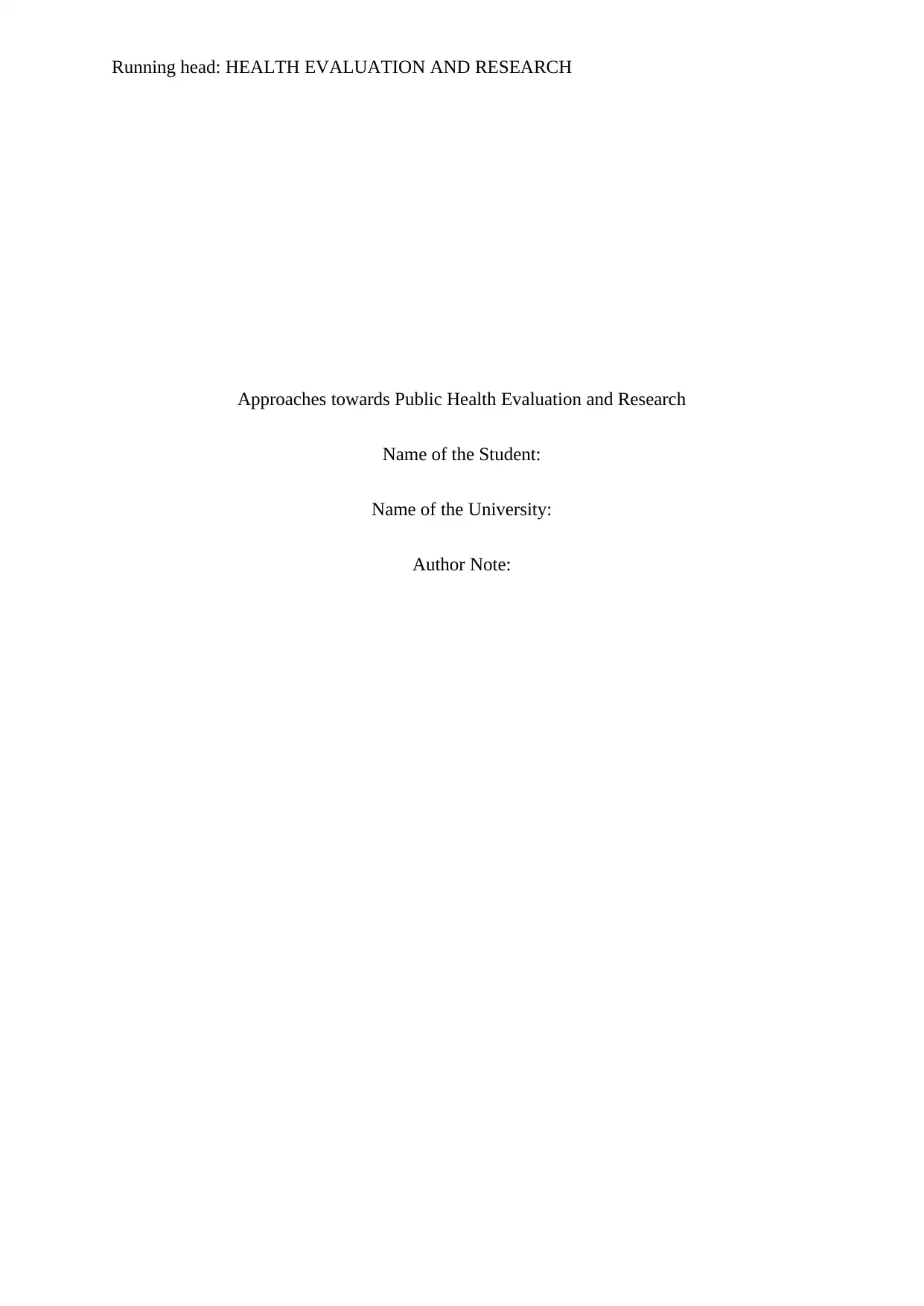
Running head: HEALTH EVALUATION AND RESEARCH
Approaches towards Public Health Evaluation and Research
Name of the Student:
Name of the University:
Author Note:
Approaches towards Public Health Evaluation and Research
Name of the Student:
Name of the University:
Author Note:
Paraphrase This Document
Need a fresh take? Get an instant paraphrase of this document with our AI Paraphraser
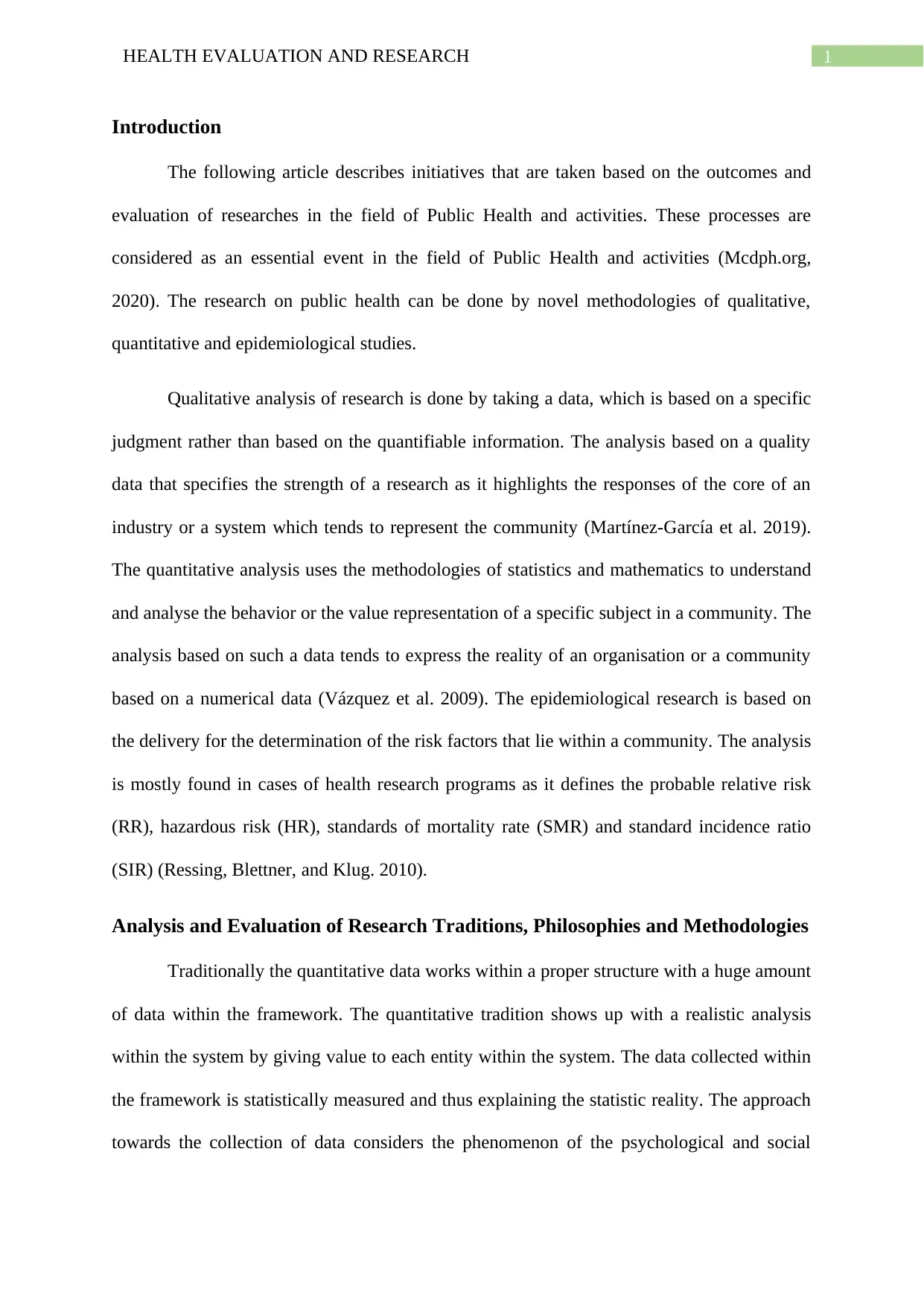
1HEALTH EVALUATION AND RESEARCH
Introduction
The following article describes initiatives that are taken based on the outcomes and
evaluation of researches in the field of Public Health and activities. These processes are
considered as an essential event in the field of Public Health and activities (Mcdph.org,
2020). The research on public health can be done by novel methodologies of qualitative,
quantitative and epidemiological studies.
Qualitative analysis of research is done by taking a data, which is based on a specific
judgment rather than based on the quantifiable information. The analysis based on a quality
data that specifies the strength of a research as it highlights the responses of the core of an
industry or a system which tends to represent the community (Martínez-García et al. 2019).
The quantitative analysis uses the methodologies of statistics and mathematics to understand
and analyse the behavior or the value representation of a specific subject in a community. The
analysis based on such a data tends to express the reality of an organisation or a community
based on a numerical data (Vázquez et al. 2009). The epidemiological research is based on
the delivery for the determination of the risk factors that lie within a community. The analysis
is mostly found in cases of health research programs as it defines the probable relative risk
(RR), hazardous risk (HR), standards of mortality rate (SMR) and standard incidence ratio
(SIR) (Ressing, Blettner, and Klug. 2010).
Analysis and Evaluation of Research Traditions, Philosophies and Methodologies
Traditionally the quantitative data works within a proper structure with a huge amount
of data within the framework. The quantitative tradition shows up with a realistic analysis
within the system by giving value to each entity within the system. The data collected within
the framework is statistically measured and thus explaining the statistic reality. The approach
towards the collection of data considers the phenomenon of the psychological and social
Introduction
The following article describes initiatives that are taken based on the outcomes and
evaluation of researches in the field of Public Health and activities. These processes are
considered as an essential event in the field of Public Health and activities (Mcdph.org,
2020). The research on public health can be done by novel methodologies of qualitative,
quantitative and epidemiological studies.
Qualitative analysis of research is done by taking a data, which is based on a specific
judgment rather than based on the quantifiable information. The analysis based on a quality
data that specifies the strength of a research as it highlights the responses of the core of an
industry or a system which tends to represent the community (Martínez-García et al. 2019).
The quantitative analysis uses the methodologies of statistics and mathematics to understand
and analyse the behavior or the value representation of a specific subject in a community. The
analysis based on such a data tends to express the reality of an organisation or a community
based on a numerical data (Vázquez et al. 2009). The epidemiological research is based on
the delivery for the determination of the risk factors that lie within a community. The analysis
is mostly found in cases of health research programs as it defines the probable relative risk
(RR), hazardous risk (HR), standards of mortality rate (SMR) and standard incidence ratio
(SIR) (Ressing, Blettner, and Klug. 2010).
Analysis and Evaluation of Research Traditions, Philosophies and Methodologies
Traditionally the quantitative data works within a proper structure with a huge amount
of data within the framework. The quantitative tradition shows up with a realistic analysis
within the system by giving value to each entity within the system. The data collected within
the framework is statistically measured and thus explaining the statistic reality. The approach
towards the collection of data considers the phenomenon of the psychological and social
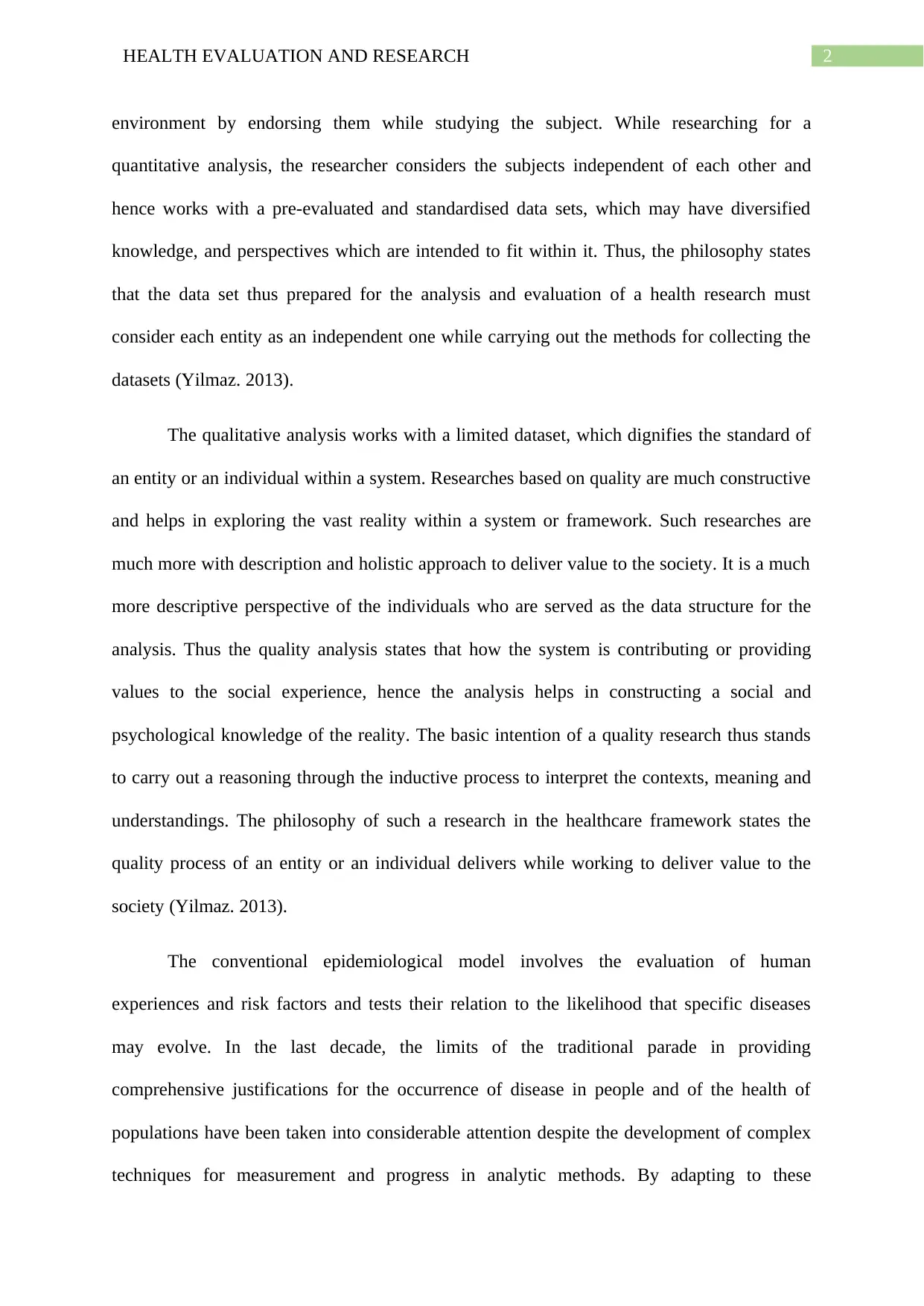
2HEALTH EVALUATION AND RESEARCH
environment by endorsing them while studying the subject. While researching for a
quantitative analysis, the researcher considers the subjects independent of each other and
hence works with a pre-evaluated and standardised data sets, which may have diversified
knowledge, and perspectives which are intended to fit within it. Thus, the philosophy states
that the data set thus prepared for the analysis and evaluation of a health research must
consider each entity as an independent one while carrying out the methods for collecting the
datasets (Yilmaz. 2013).
The qualitative analysis works with a limited dataset, which dignifies the standard of
an entity or an individual within a system. Researches based on quality are much constructive
and helps in exploring the vast reality within a system or framework. Such researches are
much more with description and holistic approach to deliver value to the society. It is a much
more descriptive perspective of the individuals who are served as the data structure for the
analysis. Thus the quality analysis states that how the system is contributing or providing
values to the social experience, hence the analysis helps in constructing a social and
psychological knowledge of the reality. The basic intention of a quality research thus stands
to carry out a reasoning through the inductive process to interpret the contexts, meaning and
understandings. The philosophy of such a research in the healthcare framework states the
quality process of an entity or an individual delivers while working to deliver value to the
society (Yilmaz. 2013).
The conventional epidemiological model involves the evaluation of human
experiences and risk factors and tests their relation to the likelihood that specific diseases
may evolve. In the last decade, the limits of the traditional parade in providing
comprehensive justifications for the occurrence of disease in people and of the health of
populations have been taken into considerable attention despite the development of complex
techniques for measurement and progress in analytic methods. By adapting to these
environment by endorsing them while studying the subject. While researching for a
quantitative analysis, the researcher considers the subjects independent of each other and
hence works with a pre-evaluated and standardised data sets, which may have diversified
knowledge, and perspectives which are intended to fit within it. Thus, the philosophy states
that the data set thus prepared for the analysis and evaluation of a health research must
consider each entity as an independent one while carrying out the methods for collecting the
datasets (Yilmaz. 2013).
The qualitative analysis works with a limited dataset, which dignifies the standard of
an entity or an individual within a system. Researches based on quality are much constructive
and helps in exploring the vast reality within a system or framework. Such researches are
much more with description and holistic approach to deliver value to the society. It is a much
more descriptive perspective of the individuals who are served as the data structure for the
analysis. Thus the quality analysis states that how the system is contributing or providing
values to the social experience, hence the analysis helps in constructing a social and
psychological knowledge of the reality. The basic intention of a quality research thus stands
to carry out a reasoning through the inductive process to interpret the contexts, meaning and
understandings. The philosophy of such a research in the healthcare framework states the
quality process of an entity or an individual delivers while working to deliver value to the
society (Yilmaz. 2013).
The conventional epidemiological model involves the evaluation of human
experiences and risk factors and tests their relation to the likelihood that specific diseases
may evolve. In the last decade, the limits of the traditional parade in providing
comprehensive justifications for the occurrence of disease in people and of the health of
populations have been taken into considerable attention despite the development of complex
techniques for measurement and progress in analytic methods. By adapting to these
⊘ This is a preview!⊘
Do you want full access?
Subscribe today to unlock all pages.

Trusted by 1+ million students worldwide
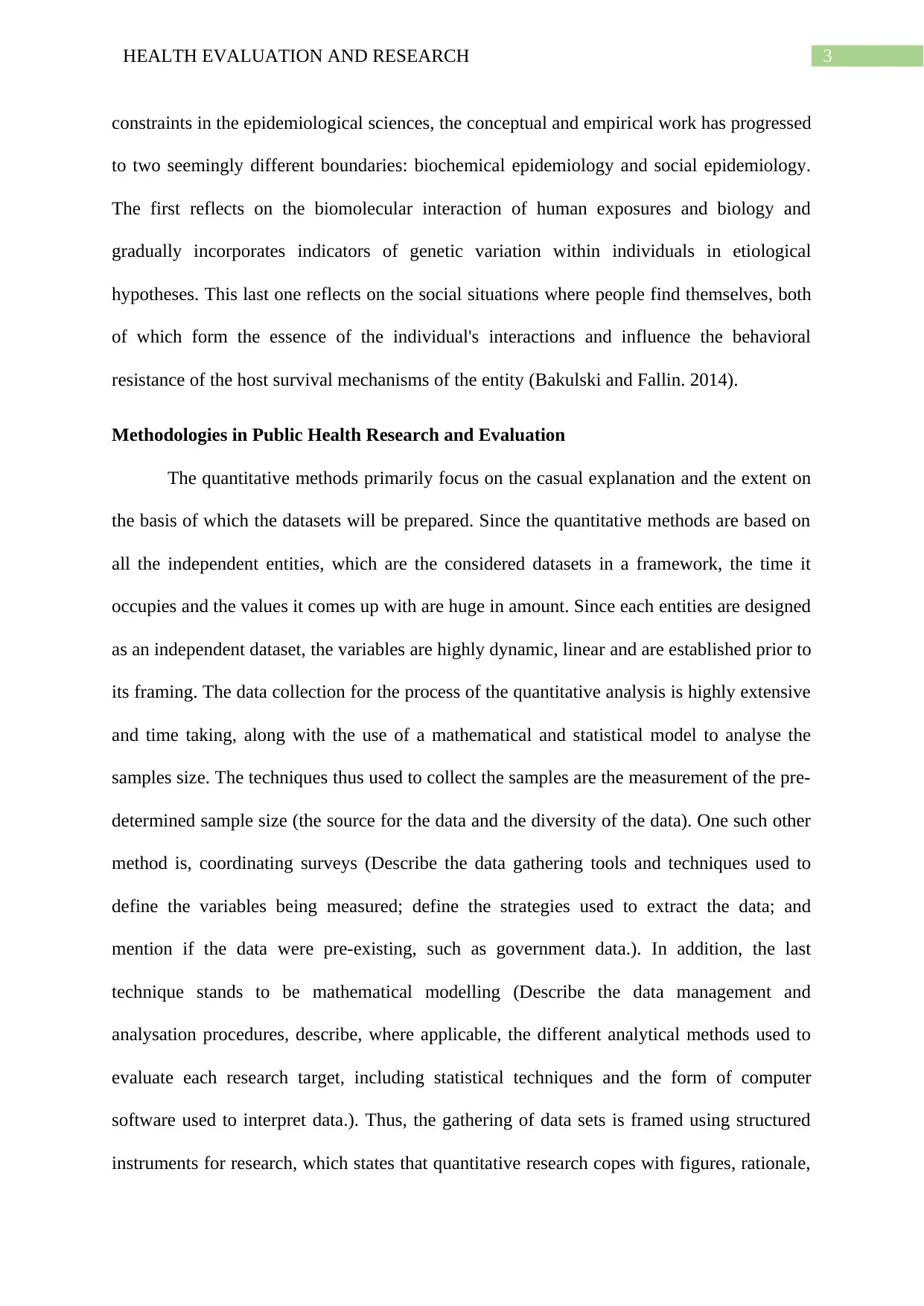
3HEALTH EVALUATION AND RESEARCH
constraints in the epidemiological sciences, the conceptual and empirical work has progressed
to two seemingly different boundaries: biochemical epidemiology and social epidemiology.
The first reflects on the biomolecular interaction of human exposures and biology and
gradually incorporates indicators of genetic variation within individuals in etiological
hypotheses. This last one reflects on the social situations where people find themselves, both
of which form the essence of the individual's interactions and influence the behavioral
resistance of the host survival mechanisms of the entity (Bakulski and Fallin. 2014).
Methodologies in Public Health Research and Evaluation
The quantitative methods primarily focus on the casual explanation and the extent on
the basis of which the datasets will be prepared. Since the quantitative methods are based on
all the independent entities, which are the considered datasets in a framework, the time it
occupies and the values it comes up with are huge in amount. Since each entities are designed
as an independent dataset, the variables are highly dynamic, linear and are established prior to
its framing. The data collection for the process of the quantitative analysis is highly extensive
and time taking, along with the use of a mathematical and statistical model to analyse the
samples size. The techniques thus used to collect the samples are the measurement of the pre-
determined sample size (the source for the data and the diversity of the data). One such other
method is, coordinating surveys (Describe the data gathering tools and techniques used to
define the variables being measured; define the strategies used to extract the data; and
mention if the data were pre-existing, such as government data.). In addition, the last
technique stands to be mathematical modelling (Describe the data management and
analysation procedures, describe, where applicable, the different analytical methods used to
evaluate each research target, including statistical techniques and the form of computer
software used to interpret data.). Thus, the gathering of data sets is framed using structured
instruments for research, which states that quantitative research copes with figures, rationale,
constraints in the epidemiological sciences, the conceptual and empirical work has progressed
to two seemingly different boundaries: biochemical epidemiology and social epidemiology.
The first reflects on the biomolecular interaction of human exposures and biology and
gradually incorporates indicators of genetic variation within individuals in etiological
hypotheses. This last one reflects on the social situations where people find themselves, both
of which form the essence of the individual's interactions and influence the behavioral
resistance of the host survival mechanisms of the entity (Bakulski and Fallin. 2014).
Methodologies in Public Health Research and Evaluation
The quantitative methods primarily focus on the casual explanation and the extent on
the basis of which the datasets will be prepared. Since the quantitative methods are based on
all the independent entities, which are the considered datasets in a framework, the time it
occupies and the values it comes up with are huge in amount. Since each entities are designed
as an independent dataset, the variables are highly dynamic, linear and are established prior to
its framing. The data collection for the process of the quantitative analysis is highly extensive
and time taking, along with the use of a mathematical and statistical model to analyse the
samples size. The techniques thus used to collect the samples are the measurement of the pre-
determined sample size (the source for the data and the diversity of the data). One such other
method is, coordinating surveys (Describe the data gathering tools and techniques used to
define the variables being measured; define the strategies used to extract the data; and
mention if the data were pre-existing, such as government data.). In addition, the last
technique stands to be mathematical modelling (Describe the data management and
analysation procedures, describe, where applicable, the different analytical methods used to
evaluate each research target, including statistical techniques and the form of computer
software used to interpret data.). Thus, the gathering of data sets is framed using structured
instruments for research, which states that quantitative research copes with figures, rationale,
Paraphrase This Document
Need a fresh take? Get an instant paraphrase of this document with our AI Paraphraser
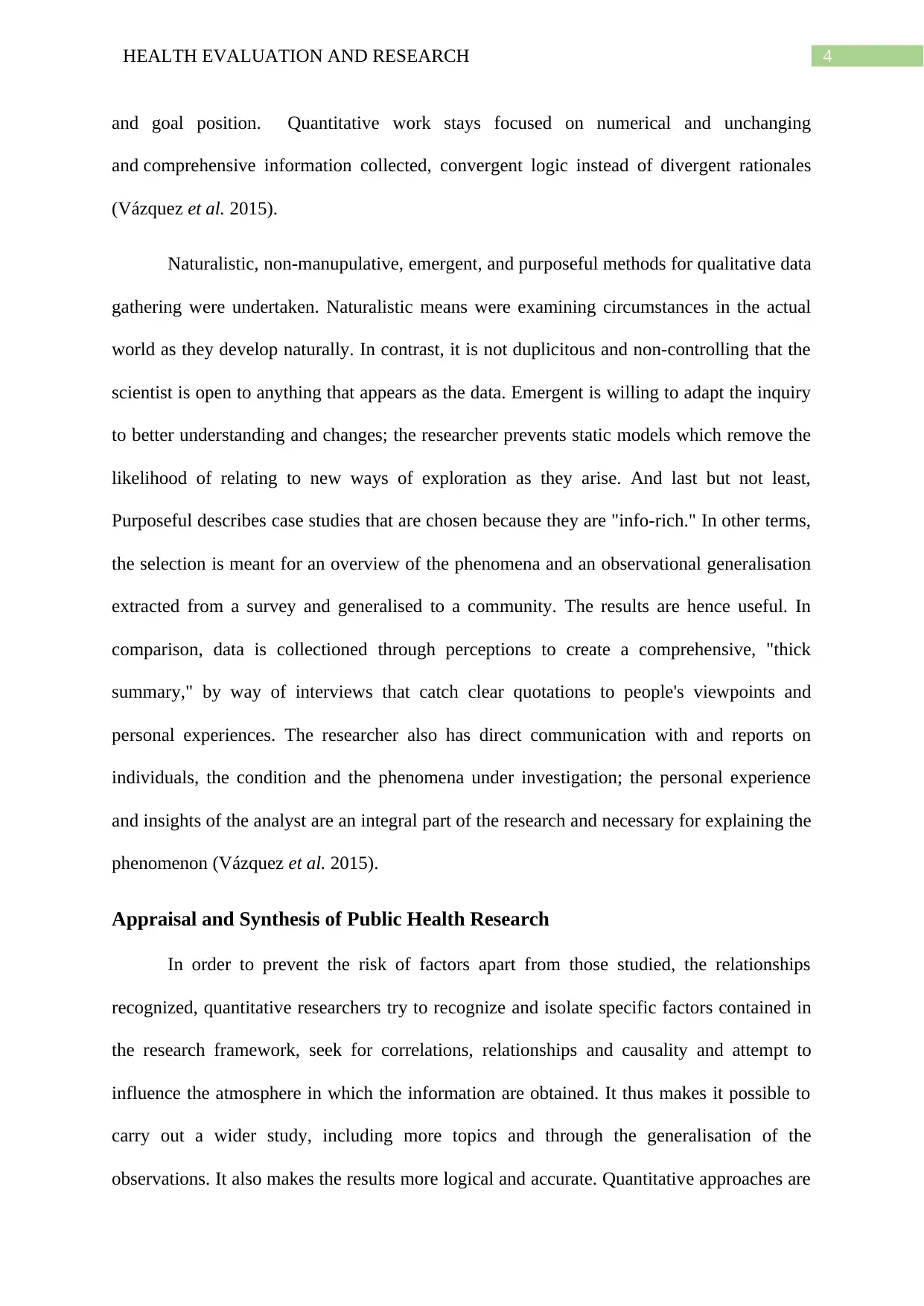
4HEALTH EVALUATION AND RESEARCH
and goal position. Quantitative work stays focused on numerical and unchanging
and comprehensive information collected, convergent logic instead of divergent rationales
(Vázquez et al. 2015).
Naturalistic, non-manupulative, emergent, and purposeful methods for qualitative data
gathering were undertaken. Naturalistic means were examining circumstances in the actual
world as they develop naturally. In contrast, it is not duplicitous and non-controlling that the
scientist is open to anything that appears as the data. Emergent is willing to adapt the inquiry
to better understanding and changes; the researcher prevents static models which remove the
likelihood of relating to new ways of exploration as they arise. And last but not least,
Purposeful describes case studies that are chosen because they are "info-rich." In other terms,
the selection is meant for an overview of the phenomena and an observational generalisation
extracted from a survey and generalised to a community. The results are hence useful. In
comparison, data is collectioned through perceptions to create a comprehensive, "thick
summary," by way of interviews that catch clear quotations to people's viewpoints and
personal experiences. The researcher also has direct communication with and reports on
individuals, the condition and the phenomena under investigation; the personal experience
and insights of the analyst are an integral part of the research and necessary for explaining the
phenomenon (Vázquez et al. 2015).
Appraisal and Synthesis of Public Health Research
In order to prevent the risk of factors apart from those studied, the relationships
recognized, quantitative researchers try to recognize and isolate specific factors contained in
the research framework, seek for correlations, relationships and causality and attempt to
influence the atmosphere in which the information are obtained. It thus makes it possible to
carry out a wider study, including more topics and through the generalisation of the
observations. It also makes the results more logical and accurate. Quantitative approaches are
and goal position. Quantitative work stays focused on numerical and unchanging
and comprehensive information collected, convergent logic instead of divergent rationales
(Vázquez et al. 2015).
Naturalistic, non-manupulative, emergent, and purposeful methods for qualitative data
gathering were undertaken. Naturalistic means were examining circumstances in the actual
world as they develop naturally. In contrast, it is not duplicitous and non-controlling that the
scientist is open to anything that appears as the data. Emergent is willing to adapt the inquiry
to better understanding and changes; the researcher prevents static models which remove the
likelihood of relating to new ways of exploration as they arise. And last but not least,
Purposeful describes case studies that are chosen because they are "info-rich." In other terms,
the selection is meant for an overview of the phenomena and an observational generalisation
extracted from a survey and generalised to a community. The results are hence useful. In
comparison, data is collectioned through perceptions to create a comprehensive, "thick
summary," by way of interviews that catch clear quotations to people's viewpoints and
personal experiences. The researcher also has direct communication with and reports on
individuals, the condition and the phenomena under investigation; the personal experience
and insights of the analyst are an integral part of the research and necessary for explaining the
phenomenon (Vázquez et al. 2015).
Appraisal and Synthesis of Public Health Research
In order to prevent the risk of factors apart from those studied, the relationships
recognized, quantitative researchers try to recognize and isolate specific factors contained in
the research framework, seek for correlations, relationships and causality and attempt to
influence the atmosphere in which the information are obtained. It thus makes it possible to
carry out a wider study, including more topics and through the generalisation of the
observations. It also makes the results more logical and accurate. Quantitative approaches are
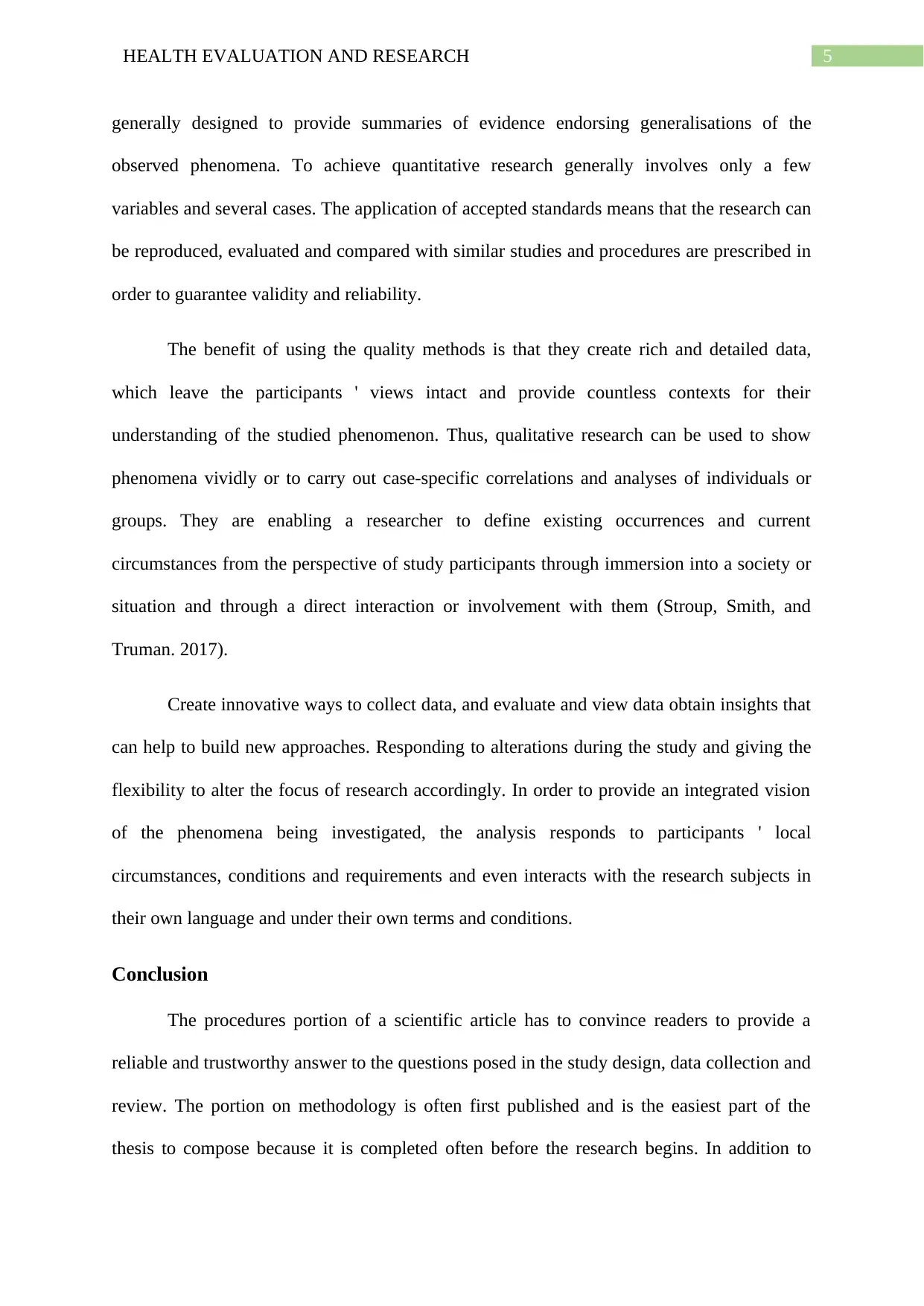
5HEALTH EVALUATION AND RESEARCH
generally designed to provide summaries of evidence endorsing generalisations of the
observed phenomena. To achieve quantitative research generally involves only a few
variables and several cases. The application of accepted standards means that the research can
be reproduced, evaluated and compared with similar studies and procedures are prescribed in
order to guarantee validity and reliability.
The benefit of using the quality methods is that they create rich and detailed data,
which leave the participants ' views intact and provide countless contexts for their
understanding of the studied phenomenon. Thus, qualitative research can be used to show
phenomena vividly or to carry out case-specific correlations and analyses of individuals or
groups. They are enabling a researcher to define existing occurrences and current
circumstances from the perspective of study participants through immersion into a society or
situation and through a direct interaction or involvement with them (Stroup, Smith, and
Truman. 2017).
Create innovative ways to collect data, and evaluate and view data obtain insights that
can help to build new approaches. Responding to alterations during the study and giving the
flexibility to alter the focus of research accordingly. In order to provide an integrated vision
of the phenomena being investigated, the analysis responds to participants ' local
circumstances, conditions and requirements and even interacts with the research subjects in
their own language and under their own terms and conditions.
Conclusion
The procedures portion of a scientific article has to convince readers to provide a
reliable and trustworthy answer to the questions posed in the study design, data collection and
review. The portion on methodology is often first published and is the easiest part of the
thesis to compose because it is completed often before the research begins. In addition to
generally designed to provide summaries of evidence endorsing generalisations of the
observed phenomena. To achieve quantitative research generally involves only a few
variables and several cases. The application of accepted standards means that the research can
be reproduced, evaluated and compared with similar studies and procedures are prescribed in
order to guarantee validity and reliability.
The benefit of using the quality methods is that they create rich and detailed data,
which leave the participants ' views intact and provide countless contexts for their
understanding of the studied phenomenon. Thus, qualitative research can be used to show
phenomena vividly or to carry out case-specific correlations and analyses of individuals or
groups. They are enabling a researcher to define existing occurrences and current
circumstances from the perspective of study participants through immersion into a society or
situation and through a direct interaction or involvement with them (Stroup, Smith, and
Truman. 2017).
Create innovative ways to collect data, and evaluate and view data obtain insights that
can help to build new approaches. Responding to alterations during the study and giving the
flexibility to alter the focus of research accordingly. In order to provide an integrated vision
of the phenomena being investigated, the analysis responds to participants ' local
circumstances, conditions and requirements and even interacts with the research subjects in
their own language and under their own terms and conditions.
Conclusion
The procedures portion of a scientific article has to convince readers to provide a
reliable and trustworthy answer to the questions posed in the study design, data collection and
review. The portion on methodology is often first published and is the easiest part of the
thesis to compose because it is completed often before the research begins. In addition to
⊘ This is a preview!⊘
Do you want full access?
Subscribe today to unlock all pages.

Trusted by 1+ million students worldwide
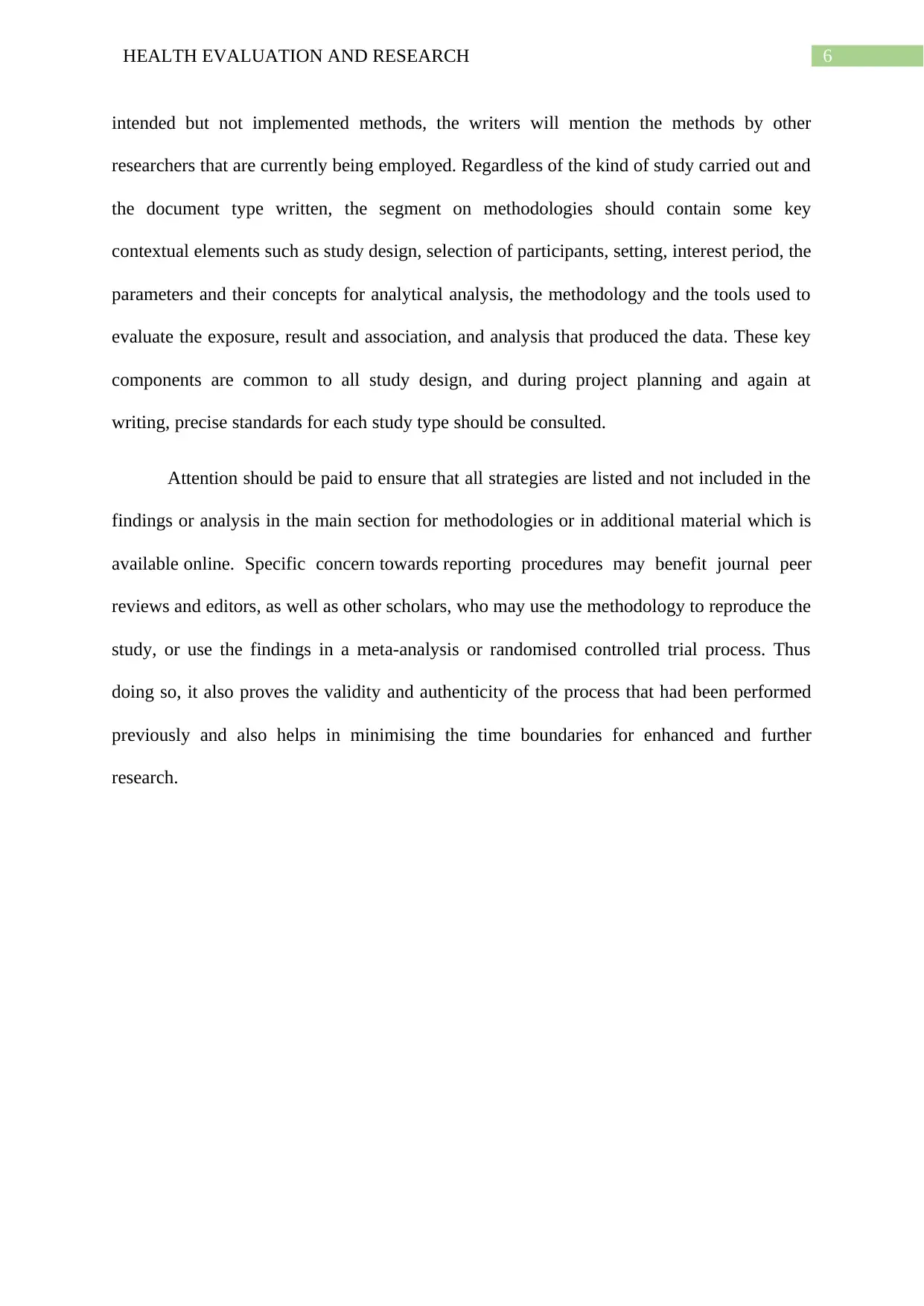
6HEALTH EVALUATION AND RESEARCH
intended but not implemented methods, the writers will mention the methods by other
researchers that are currently being employed. Regardless of the kind of study carried out and
the document type written, the segment on methodologies should contain some key
contextual elements such as study design, selection of participants, setting, interest period, the
parameters and their concepts for analytical analysis, the methodology and the tools used to
evaluate the exposure, result and association, and analysis that produced the data. These key
components are common to all study design, and during project planning and again at
writing, precise standards for each study type should be consulted.
Attention should be paid to ensure that all strategies are listed and not included in the
findings or analysis in the main section for methodologies or in additional material which is
available online. Specific concern towards reporting procedures may benefit journal peer
reviews and editors, as well as other scholars, who may use the methodology to reproduce the
study, or use the findings in a meta-analysis or randomised controlled trial process. Thus
doing so, it also proves the validity and authenticity of the process that had been performed
previously and also helps in minimising the time boundaries for enhanced and further
research.
intended but not implemented methods, the writers will mention the methods by other
researchers that are currently being employed. Regardless of the kind of study carried out and
the document type written, the segment on methodologies should contain some key
contextual elements such as study design, selection of participants, setting, interest period, the
parameters and their concepts for analytical analysis, the methodology and the tools used to
evaluate the exposure, result and association, and analysis that produced the data. These key
components are common to all study design, and during project planning and again at
writing, precise standards for each study type should be consulted.
Attention should be paid to ensure that all strategies are listed and not included in the
findings or analysis in the main section for methodologies or in additional material which is
available online. Specific concern towards reporting procedures may benefit journal peer
reviews and editors, as well as other scholars, who may use the methodology to reproduce the
study, or use the findings in a meta-analysis or randomised controlled trial process. Thus
doing so, it also proves the validity and authenticity of the process that had been performed
previously and also helps in minimising the time boundaries for enhanced and further
research.
Paraphrase This Document
Need a fresh take? Get an instant paraphrase of this document with our AI Paraphraser
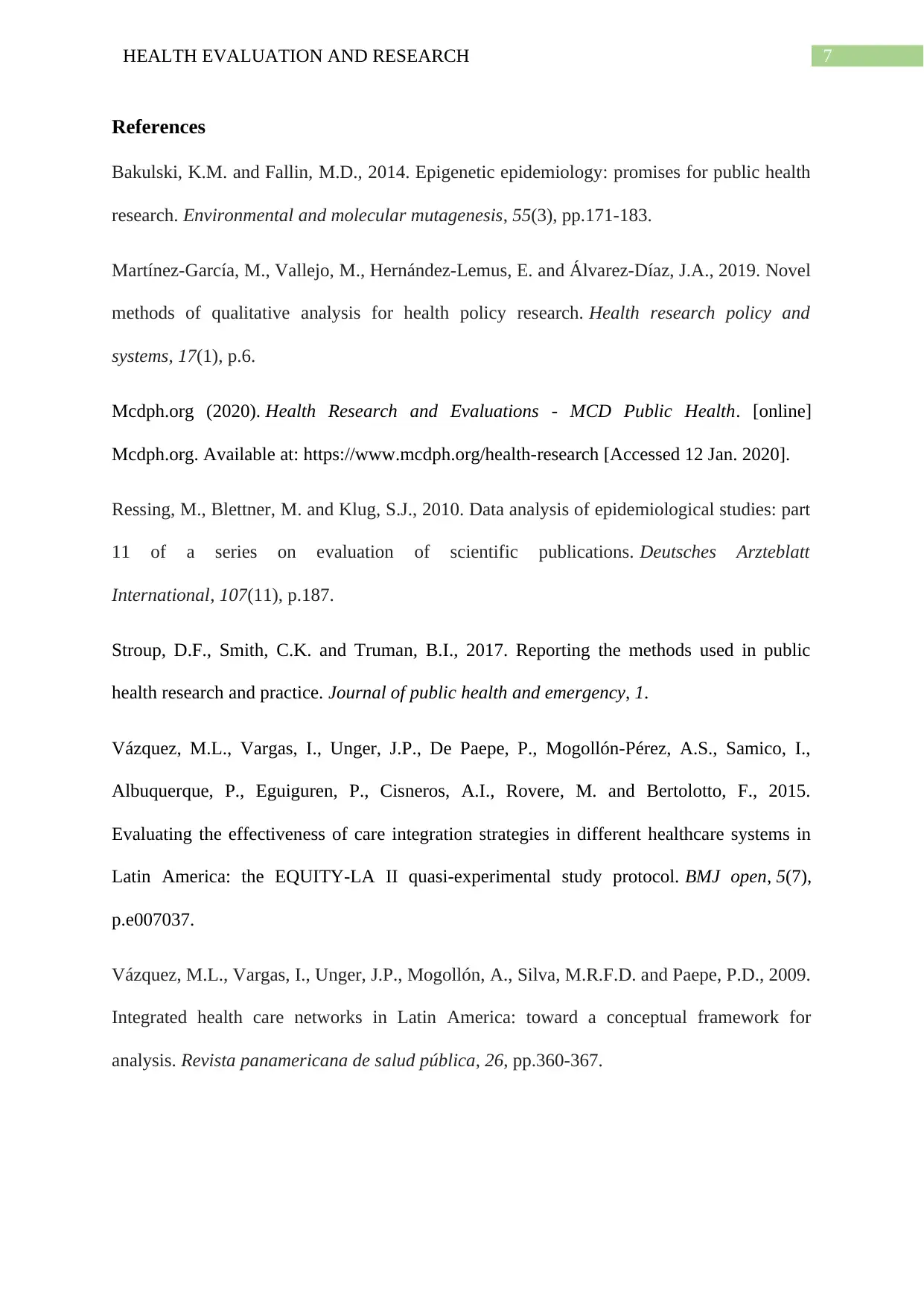
7HEALTH EVALUATION AND RESEARCH
References
Bakulski, K.M. and Fallin, M.D., 2014. Epigenetic epidemiology: promises for public health
research. Environmental and molecular mutagenesis, 55(3), pp.171-183.
Martínez-García, M., Vallejo, M., Hernández-Lemus, E. and Álvarez-Díaz, J.A., 2019. Novel
methods of qualitative analysis for health policy research. Health research policy and
systems, 17(1), p.6.
Mcdph.org (2020). Health Research and Evaluations - MCD Public Health. [online]
Mcdph.org. Available at: https://www.mcdph.org/health-research [Accessed 12 Jan. 2020].
Ressing, M., Blettner, M. and Klug, S.J., 2010. Data analysis of epidemiological studies: part
11 of a series on evaluation of scientific publications. Deutsches Arzteblatt
International, 107(11), p.187.
Stroup, D.F., Smith, C.K. and Truman, B.I., 2017. Reporting the methods used in public
health research and practice. Journal of public health and emergency, 1.
Vázquez, M.L., Vargas, I., Unger, J.P., De Paepe, P., Mogollón-Pérez, A.S., Samico, I.,
Albuquerque, P., Eguiguren, P., Cisneros, A.I., Rovere, M. and Bertolotto, F., 2015.
Evaluating the effectiveness of care integration strategies in different healthcare systems in
Latin America: the EQUITY-LA II quasi-experimental study protocol. BMJ open, 5(7),
p.e007037.
Vázquez, M.L., Vargas, I., Unger, J.P., Mogollón, A., Silva, M.R.F.D. and Paepe, P.D., 2009.
Integrated health care networks in Latin America: toward a conceptual framework for
analysis. Revista panamericana de salud pública, 26, pp.360-367.
References
Bakulski, K.M. and Fallin, M.D., 2014. Epigenetic epidemiology: promises for public health
research. Environmental and molecular mutagenesis, 55(3), pp.171-183.
Martínez-García, M., Vallejo, M., Hernández-Lemus, E. and Álvarez-Díaz, J.A., 2019. Novel
methods of qualitative analysis for health policy research. Health research policy and
systems, 17(1), p.6.
Mcdph.org (2020). Health Research and Evaluations - MCD Public Health. [online]
Mcdph.org. Available at: https://www.mcdph.org/health-research [Accessed 12 Jan. 2020].
Ressing, M., Blettner, M. and Klug, S.J., 2010. Data analysis of epidemiological studies: part
11 of a series on evaluation of scientific publications. Deutsches Arzteblatt
International, 107(11), p.187.
Stroup, D.F., Smith, C.K. and Truman, B.I., 2017. Reporting the methods used in public
health research and practice. Journal of public health and emergency, 1.
Vázquez, M.L., Vargas, I., Unger, J.P., De Paepe, P., Mogollón-Pérez, A.S., Samico, I.,
Albuquerque, P., Eguiguren, P., Cisneros, A.I., Rovere, M. and Bertolotto, F., 2015.
Evaluating the effectiveness of care integration strategies in different healthcare systems in
Latin America: the EQUITY-LA II quasi-experimental study protocol. BMJ open, 5(7),
p.e007037.
Vázquez, M.L., Vargas, I., Unger, J.P., Mogollón, A., Silva, M.R.F.D. and Paepe, P.D., 2009.
Integrated health care networks in Latin America: toward a conceptual framework for
analysis. Revista panamericana de salud pública, 26, pp.360-367.
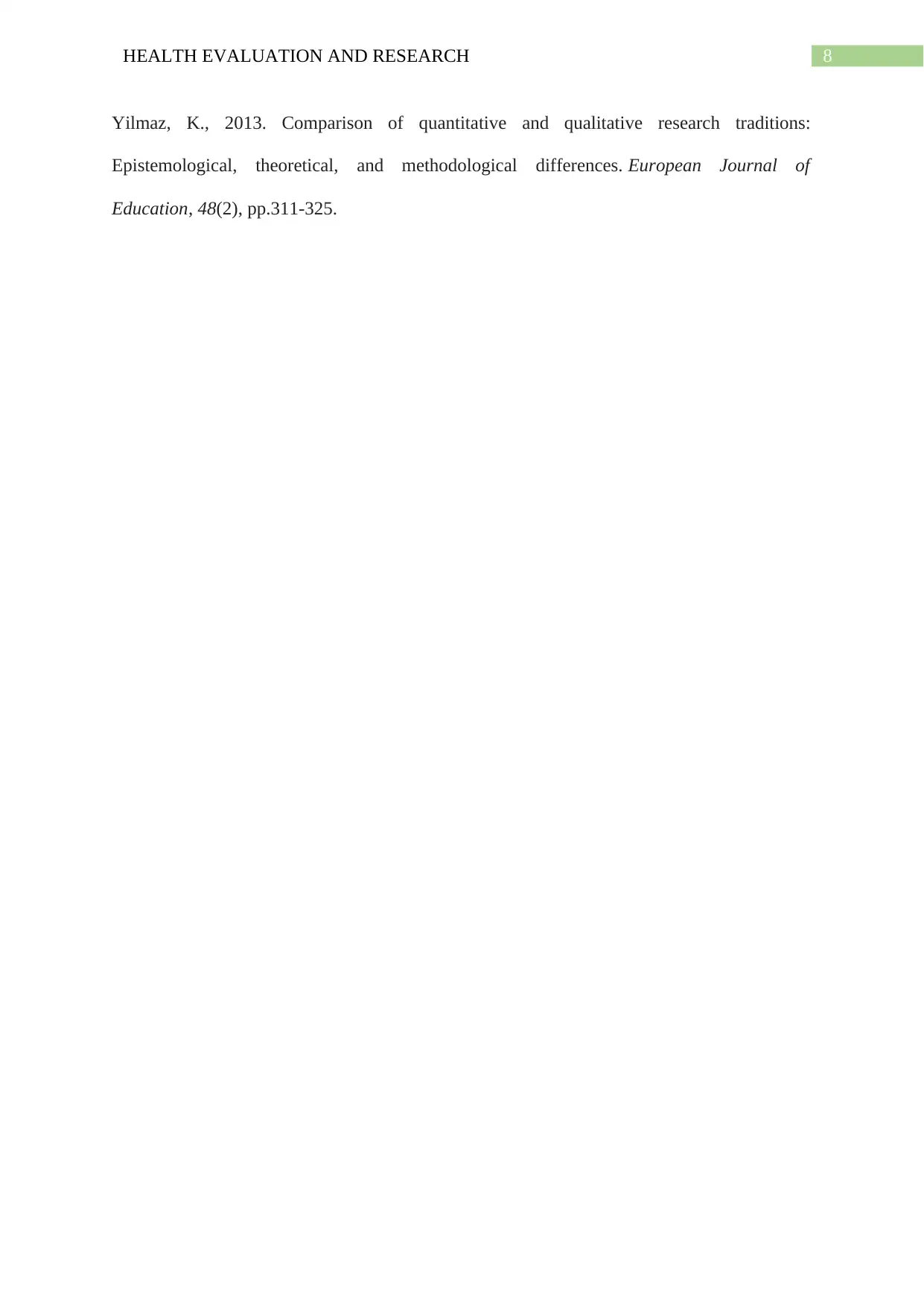
8HEALTH EVALUATION AND RESEARCH
Yilmaz, K., 2013. Comparison of quantitative and qualitative research traditions:
Epistemological, theoretical, and methodological differences. European Journal of
Education, 48(2), pp.311-325.
Yilmaz, K., 2013. Comparison of quantitative and qualitative research traditions:
Epistemological, theoretical, and methodological differences. European Journal of
Education, 48(2), pp.311-325.
⊘ This is a preview!⊘
Do you want full access?
Subscribe today to unlock all pages.

Trusted by 1+ million students worldwide
1 out of 9
Related Documents
Your All-in-One AI-Powered Toolkit for Academic Success.
+13062052269
info@desklib.com
Available 24*7 on WhatsApp / Email
![[object Object]](/_next/static/media/star-bottom.7253800d.svg)
Unlock your academic potential
Copyright © 2020–2025 A2Z Services. All Rights Reserved. Developed and managed by ZUCOL.





